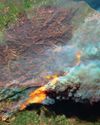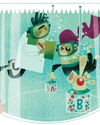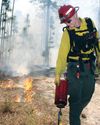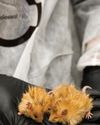From Trash To Tunes
Muse Science Magazine for Kids
|September 2019
Meet The Recycled Orchestra

Musicians in the London Philharmonic Orchestra play expensive instruments crafted from the finest materials. But in a slum in Cateura, Paraguay, in South America, an orchestra plays instruments made out of materials recycled from the trash. Their name is Orquesta de Reciclados (the Recycled Orchestra), and they perform for audiences all over the world. Cateura is now famous as the home of the Recycled Orchestra. These musicians create beautiful music out of garbage.
The musicians are all children and teens living in Cateura, a very poor community on the edge of the largest landfill in Paraguay. It’s not far from the capital city, Asunción. Every day, about 3 million pounds (1.3 million kg) of trash gets dumped in the Cateura landfill. The water supply is dangerously polluted from all the garbage. On rainy days, the town floods with dirty water. It is literally a sea of trash!

Most people who live in Cateura work as “trash pickers.” They collect recyclable materials from the landfill and sell the items for money. They look for glass bottles, aluminum cans, cardboard, or plastic. They can sell one pound of cardboard for five cents. A pound of plastic is worth ten cents. Children aren’t supposed to work in the landfill, but some do anyway because their families need their help.
Favio Chávez is an environmental engineer who went to Cateura to teach the
Bu hikaye Muse Science Magazine for Kids dergisinin September 2019 baskısından alınmıştır.
Binlerce özenle seçilmiş premium hikayeye ve 9.000'den fazla dergi ve gazeteye erişmek için Magzter GOLD'a abone olun.
Zaten abone misiniz? Oturum aç
Muse Science Magazine for Kids'den DAHA FAZLA HİKAYE

Muse Science Magazine for Kids
ANIMAL FIREFIGHTER TO THE RESCUE
Can animals help manage the risks of deadly wildfires?
3 mins
Muse July 2025: The Story Behind Wildfires

Muse Science Magazine for Kids
FIRE DANGER
WHY THE RISK OF WILDFIRES KEEPS GROWING
4 mins
Muse July 2025: The Story Behind Wildfires

Muse Science Magazine for Kids
The Miller NEW Normal
WHAT TODAY’S WILDFIRES TELL US ABOUT OUR FUTURE
8 mins
Muse July 2025: The Story Behind Wildfires

Muse Science Magazine for Kids
WOMEN AND FIREFIGHTING: A GOOD FIT
Jessica Gardetto is a firefighter. Her father was, too. “I grew up with my dad coming home smelling like wildfire and covered in soot,” she says.
1 min
Muse July 2025: The Story Behind Wildfires

Muse Science Magazine for Kids
What is happening on your fingertips when they get all wrinkly in a hot tub?
—Felix G., age 10, Montana
1 mins
Muse July 2025: The Story Behind Wildfires

Muse Science Magazine for Kids
WHEN the SMOKE CLEARS
THE LINGERING EFFECTS OF THE RECENT PACIFIC PALISADES AND ALTADENA EATON FIRES
6 mins
Muse July 2025: The Story Behind Wildfires

Muse Science Magazine for Kids
PICKING TEAMS
Keep it fair with a strategy that relies on geometry.
2 mins
Muse July 2025: The Story Behind Wildfires

Muse Science Magazine for Kids
SHAN CAMMACK
WILDLIFE BIOLOGIST AND FIRE SAFETY OFFICER
3 mins
Muse July 2025: The Story Behind Wildfires

Muse Science Magazine for Kids
Scientists Create Mice With Woolly Mammoth-Like Fur
RESEARCHERS AT A COMPANY IN TEXAS ARE WORKING TO CREATE A LIVING ANIMAL THAT RESEMBLES THE EXTINCT WOOLLY MAMMOTH. Recently, they produced mice with traits of the large mammal. The mice all have coats with mammoth-like fur, and some of the small mammals also have genes that help them store fat. Both features would help the animals survive in the cold Arctic, where the woolly mammoth once lived.
1 min
Muse July 2025: The Story Behind Wildfires

Muse Science Magazine for Kids
Cool Sunshade Added to the Nancy Roman Space Telescope
THE NANCY ROMAN SPACE TELESCOPE IS A NEW TELESCOPE THAT NASA IS BUILDING AND WILL LAUNCH INTO SPACE, LIKELY IN EARLY 2027.
1 min
Muse July 2025: The Story Behind Wildfires
Translate
Change font size

